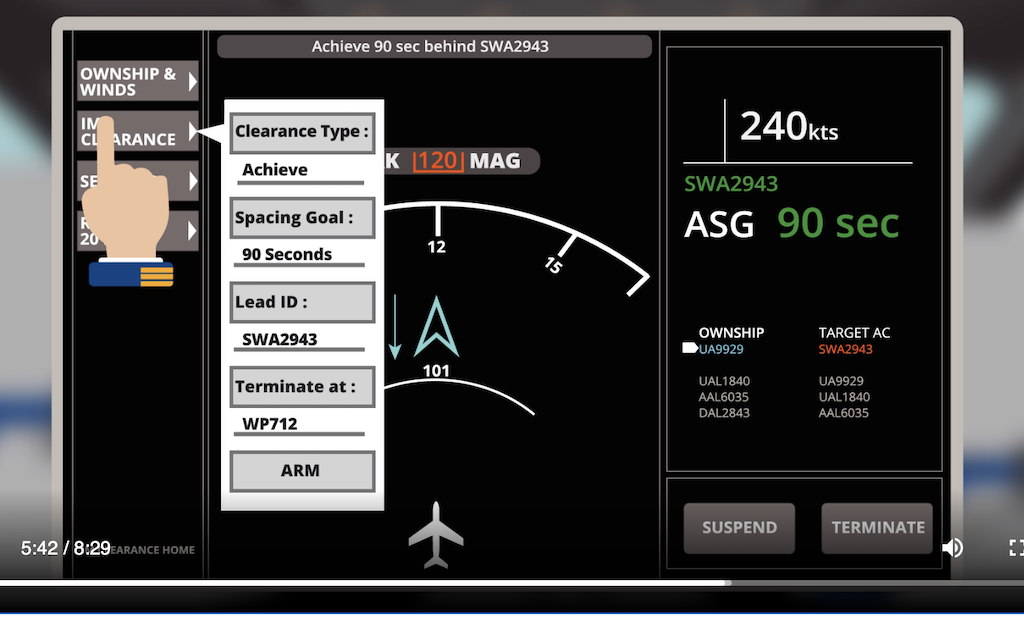
An ADS-B Guidance Display
One of the long-standing goals of the FAA’s Air Traffic Organization has been to give pilots the tools to separate themselves from airplanes ahead. That concept is about to be tested. American Airlines plans to begin working with Albuquerque Center for flights into and out of Dallas Fort Worth International Airport (DFW) using automated interval management equipment.
American’s Airbus A321s have been equipped with Cockpit Display of Traffic Information (CDTI) systems. The system uses ADS-B information to improve flight crews’ awareness of surrounding traffic. Like with other ADS-B-equipped aircraft, crews can see other aircraft on the CDTI displays. However, this information will be used for more than just awareness.
The system can be used to assign traffic to follow and speed guidance to maintain a time or distance interval behind specific aircraft. This can be done in both the airport and enroute environment. During approaches it may be used with or without visual contact with the traffic ahead by the pilot.
Many were the times I approached major airports like Phoenix (PHX) or Newark (EWR) maintaining best forward speed at the request of the approach controller, only to be told after switching to the tower that I had 60 kts overtake on the plane ahead and to slow immediately to minimum approach speed. CDTI Assisted Separation (CAS) should provide pilots a better way to see the traffic and maintain a more stabilized approach.
In the climb, cruise and descent segments, Interval management (IM) and In-Trail Procedure (ITP) will provide more precise spacing intervals than current ground-based methods can. The efficiencies gained should result in more airplanes able to use the airspace and less aircraft fuel burned.
ADS-B Guidance Display
A key part of the system for pilots is the ADS-B Guidance Display (AGD), which provides a graphical display of surrounding traffic. It includes TCAS data, but the airplane’s primary flight display and navigation display are still the primary means of getting TCAS data, including TA (Traffic Advisory) and RA (Resolution Advisory) events. When ITP is introduced, the AGD will provide a vertical display of traffic.
To tell the story of how all the pieces of the very complex automated system will work, the FAA has produced a National Airspace System (NAS) animated storyboard (see link below). The website provides multiple musically enhanced animations that explain operational views, system views, human factors and maps of deployment. The story on IM takes about 8 min. to view and is heavy on acronyms.
The animated storyboards are not your traditional FAA formal guidance, like an advisory circular or a regulation. They are an introduction to a new way of interacting with ATC, more of an IT plan than operational guidance. Get used to terms like time-based flow management (TBFM), assigned spacing goals (ASG), enroute automation modernization (ERAM), standard terminal automation replacement system (STARS), scheduled time of arrival (STA) and planned termination point (PTS). They may soon become another part of the pilot’s lexicon.
Two things I notice about the storyboards are the emphasis on efficiency and the role of the controller. They use terms like “greater throughput,” “greater efficiency,” and “inter-aircraft spacing,” reflective of IT goals, not aviation goals. The Human Factors storyboard only addresses controller concerns. Pilots appear mostly as little cartoon hands pushing buttons.
What I haven’t found so far is what role safety management will play in IM. Safety management is supposed to anticipate potential hazards and find ways to work around them.
I am thinking of a line of 10 or 15 big jets approaching a prodigious squall line west of Omaha like a column of Russian armor. What will happen when the fireworks hit the first guy? There should be a plan for that.
I have looked in vain for any FAA Flight Standards involvement in the development and rollout of IM. Maybe it’s there and I just missed it. FAA Flight Standards is a vast space. I thought perhaps the Office of Safety Standards might be a good place to look. They have a Flight Technologies and Procedures Division, and the Flight Research and Analysis Group says they “ensure safe and efficient flight paths from takeoff to landing and provide operational safety reviews and support to the NAS.” Maybe they are working on IM.
There must be some grey-haired pilots working at FAA who know about jet streams, mountain waves, wake turbulence, passenger and mechanical emergencies, buffet boundaries, icing, optimum cruise speeds and pop-up traffic on final approach. They must know about the risk of spending too much time head down instead of looking ahead. They might wonder about the wisdom of automatically following a leader who is getting too close to a thunderstorm. They might express concern about too much reliance on automation. Some of them must be working on how these common problems might affect the use of CAS, IM and ITP. I’d like to hear more from them.
We are on the cusp of some major new advances in automation use in aviation, and I expect that some of these risk factors will be considered in FAA planning.
See the FAA’s NAS Animated Storyboard at:
https://www.faa.gov/about/office_org/headquarters_offices/ang/offices/t…





